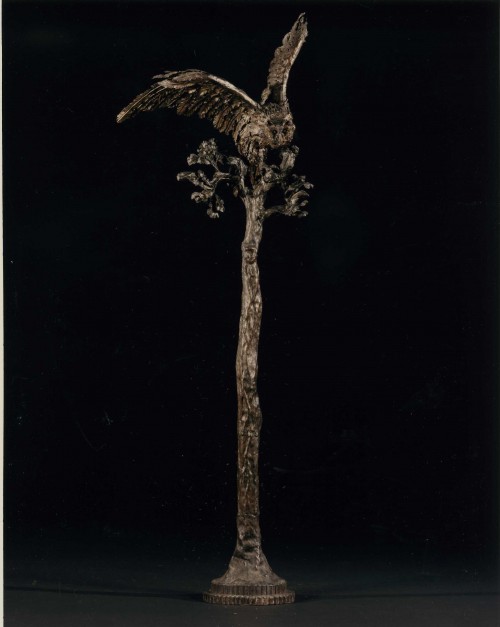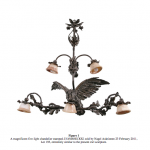9837 AN EXTREMELY FINE WROUGHT IRON SCULPTURE OF AN OWL STAMPED L VAN BOECKEL Belgian. First Quarter Of The Twentieth Century. Measurements: Height: 81″ (206 cm) Wingspan: 34″ (87 cm)

-
Figure 1
-
Figure 2
Research
Of wrought iron. A carefully observed and hand-formed study of an owl in a predatory position, perched on a stump.
Marks:
Stamped:
LVANBOECKEL
Louis Van Boeckel (1857-1944) of Lier, Belgium, was one of the most important ornamental blacksmiths of his time. He was an apprentice to the Verwilt factory in Lier, but developed most of his skills as an artisan by himself. His work, including some of his important animal depictions, can be found in the Timmermanns-Opsomer-Haus Museum in Lier.
Van Boeckel’s numerous awards included the gold medal at the Exposition du Cercle Rubens (1890), le Prix de l’Art appliqué à la rue, Brussels (1893) and the Grande Médaille d’Or and title of Chevalier de l’ordre Royal du Cambodge at the Exposition Universelle in Paris (1900). He is also responsible for work on the grid of the city hall of Lier after 1890, the grave decorations for Czar Alexander III in St. Petersburg and Queen Marie-Henriette in Laeken, the staircases of honor of the Khedive Palace in Cairo and Benedictine monastery on Mount Olive, Jerusalem, parapets of National Bank of Athens, the cathedral of Santo Rio in Buenos Aires and the White House in Washington, D.C.
A magnificent five-light chandelier (figure 1) sold by Nagel Auktionen 23 February 2011, Lot 193, is extremely similar to the present owl sculpture and further confirms its origin. The chandelier was equally stamped LVANBOECKEL on the left wing of the owl and, interestingly, was sold with its original invoice from 1929.
Van Boeckel’s work is very delicate and detailed, particularly after 1900, when he traded his decorative style for a much more imaginative manner of depiction. Figure 2 depicts the artist in his studio. An article on the sculptor in the February 1907 issue of Technical Review describes him as having an “obliging disposition,” always eager to show visitors his work in progress. He replaced the bell pull of his studio in Lier with a small, forged iron tree branch and upon offering cigars to his guests, would rain blows upon a piece of iron until it was red hot enough to light them. His hearty good will was felt in a parting handshake: “the visitor feels that he is grasping the only hand in the world that can transform a piece of scrap iron into an art object the equal of any a jeweler has ever produced.”1
Footnotes:
1. “An Art Smith And His Work.” Technical Literature Volume I, No. 2 (1907): 49-50. Print.




Comments are closed.